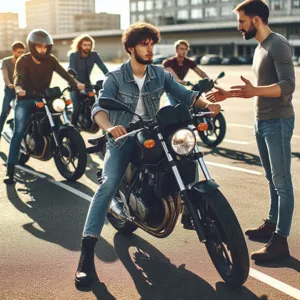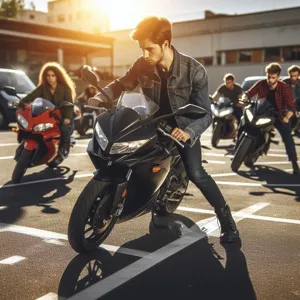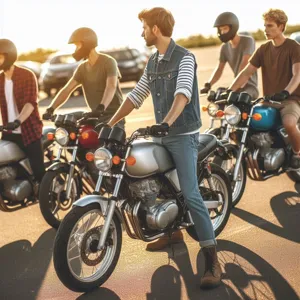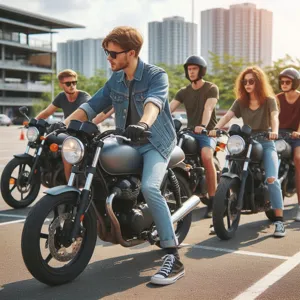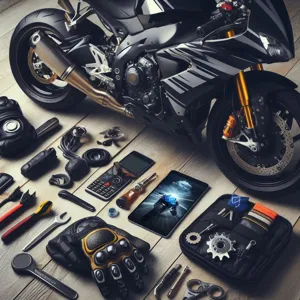For many, riding a motorbike is more than just a mode of transportation; it’s a thrilling adventure that combines freedom, skill, and the open road.
However, mastering the art of motorbike handling is crucial for both safety and enjoyment. Whether you’re a seasoned rider looking to sharpen your skills or a newcomer eager to build a solid foundation, understanding the nuances of bike control can dramatically enhance your riding experience. In this blog post, we’ll explore essential tips and techniques that can help you improve your motorbike handling skills, from body positioning and throttle control to cornering techniques and braking strategies. Get ready to elevate your riding game and embrace the exhilaration of the road with confidence and precision. Let’s dive into the world of motorbike mastery and ensure every ride is both safe and unforgettable!
1. Understanding the Basics of Motorcycle Dynamics

To master the art of motorcycle handling, it’s essential to start with a solid grasp of motorcycle dynamics. Understanding how your bike behaves in various situations is the cornerstone of safe and effective riding. Every motorcycle, whether a nimble sportbike or a sturdy cruiser, has its unique set of characteristics that influence its performance on the road.
At the heart of motorcycle dynamics are three fundamental forces: traction, weight distribution, and inertia. Traction is the grip that your tires maintain on the road, and it’s crucial for maneuvering and stopping. Understanding how to maximize traction involves knowing when to lean into a turn, how to apply brakes effectively, and recognizing the impact of road conditions on your tires’ grip.
Weight distribution plays a pivotal role in how a motorcycle handles. When you lean into a corner, your body weight shifts, affecting the balance of the bike. A well-distributed weight allows for smoother turns and better control. Conversely, an unbalanced bike can lead to instability, requiring more effort to maintain control. Familiarizing yourself with your bike’s weight distribution and how to adjust it with your body position is critical for improving your handling skills.
Inertia, the tendency of an object to resist changes in its state of motion, also affects your riding. As you accelerate, decelerate, or change direction, your motorcycle’s inertia can either work with you or against you. Understanding how to manage your speed and make deliberate movements will help you navigate through curves and obstacles with confidence.
By diving deep into the fundamentals of motorcycle dynamics, you’ll not only enhance your riding ability but also build a solid foundation for advanced techniques. This knowledge empowers you to respond fluidly to changing conditions on the road, making every ride safer and more enjoyable. Embrace the mechanics of your motorcycle, and you’ll find yourself riding with greater precision and a newfound sense of freedom.
2. Importance of Proper Body Positioning
Proper body positioning is a cornerstone of effective motorbike handling, influencing everything from balance and control to comfort and performance on the road. When you’re mounted on your bike, the way you position your body can significantly impact your ability to maneuver, especially during turns, acceleration, and braking.
To start, ensure that your feet are firmly planted on the foot pegs, with your knees snug against the tank. This grip not only stabilizes your body but also allows you to channel your weight effectively. Leaning in towards the bike during a turn shifts your center of gravity and helps maintain traction, allowing for smoother and faster cornering. Conversely, during acceleration, shifting your weight slightly back helps to distribute force evenly, improving grip on the rear tire and enhancing your overall control.
Additionally, your upper body plays a critical role. Keep your arms relaxed but firm on the handlebars, allowing for quick adjustments without compromising stability. Your elbows should be slightly bent, providing you the flexibility to respond to any changes in terrain or speed. Maintaining a straight back and a slight forward lean ensures that you remain engaged with the bike, which is particularly vital when navigating obstacles or rough surfaces.
Remember that every bike is different, and what works for one may not work for another. It’s essential to practice and find the body positioning that feels natural for you and fits the unique dynamics of your motorcycle. Consistent practice will help you develop muscle memory, making it easier to instinctively adopt the correct posture when it matters most. By mastering proper body positioning, you not only enhance your handling skills but also increase your confidence on the road, making every ride safer and more enjoyable.
3. Techniques for Smooth Throttle Control

Mastering smooth throttle control is a game-changer for any rider looking to enhance their motorbike handling skills. It’s not just about the mechanical action of twisting the throttle; it’s an art that requires finesse, coordination, and an understanding of your bike’s dynamics. Smooth throttle control allows for better traction, improved cornering, and a more stable ride, ultimately making your journeys safer and more enjoyable.
To start, practice modulating the throttle with your wrist rather than making abrupt movements. This involves gently rolling on the throttle as you exit a turn rather than snapping your wrist open. Think of it as a gradual buildup of power; this technique helps maintain traction, particularly on slippery surfaces or when navigating tight corners.
Another effective technique is to visualize your throttle as a volume knob. Just as you wouldn’t crank up the volume on your stereo all at once, apply the same principle to your throttle. Start slow, allowing the bike to find its rhythm before gradually increasing power. This approach not only smooths your acceleration but also provides you with better control over the bike’s weight transfer, especially when leaning into a turn.
Additionally, practice throttle blipping during downshifts. This technique, often used in performance riding, involves matching the engine speed to the wheel speed before a shift, ensuring a seamless transition that prevents unsettling the bike. As you master this skill, you’ll notice a dramatic difference in how your bike responds, providing a more connected and confident riding experience.
Finally, remember that practice makes perfect. Find a safe, open area, such as an empty parking lot, where you can experiment with different throttle inputs without the pressure of traffic. As you engage in these exercises, pay close attention to how your bike reacts, and adjust your technique accordingly. With time and practice, you’ll find that your throttle control becomes second nature, allowing you to navigate any road with grace and confidence.
4. Mastering the Art of Cornering
Mastering the art of cornering is one of the most crucial aspects of improving your motorbike handling skills. It’s not just about leaning into the turn; it’s about understanding the dynamics of your bike, your speed, and the road conditions. When approaching a corner, the first step is to assess the curve ahead. Look for signs indicating the sharpness of the turn and any potential hazards, such as gravel or potholes.
As you approach the corner, position your body slightly toward the inside of the turn. This technique, often referred to as “body positioning,” helps lower the center of gravity, providing better balance and control. Shift your weight onto the pegs and gently roll off the throttle, allowing the bike to settle into its natural line. Remember, smooth inputs are key; abrupt changes can unsettle the bike and lead to unwanted skidding or instability.
As you enter the corner, maintain a steady speed by gently applying the brakes if necessary. Traction is your best friend here, so be mindful of how much throttle you give while leaning into the turn. Use your eyes to look toward the exit of the corner, guiding your bike through with your gaze. This instinctive action helps your brain calculate the necessary adjustments to your steering and throttle.
Once you reach the apex of the corner, gradually roll on the throttle to power out smoothly. This is where many riders falter, either accelerating too aggressively or hesitating, which can result in a loss of momentum. Practice makes perfect, so take the time to familiarize yourself with the nuances of cornering on different types of roads and surfaces.
When you master the art of cornering, not only will you enjoy a more exhilarating ride, but you’ll also gain confidence in your handling skills, allowing you to tackle even the most challenging curves with ease. Remember, every corner is an opportunity to refine your technique and truly master the ride.
5. Strategies for Effective Braking

Effective braking is a critical skill for any motorbike rider, as it not only enhances your control but also significantly improves your safety on the road. Understanding and mastering the art of braking can mean the difference between a smooth ride and a potentially dangerous situation. Here are some essential strategies to elevate your braking technique and ensure you ride with confidence.
First and foremost, familiarize yourself with your bike’s braking system. Most modern motorcycles come equipped with both front and rear brakes, and knowing how to use them effectively is crucial. The front brake is the primary stopping force, typically providing about 70% of your bike’s stopping power. When applying the front brake, do so progressively; squeeze the lever gently at first, then gradually increase pressure as you slow down. This helps prevent the bike from pitching forward too abruptly, which can lead to loss of control.
In addition to mastering the front brake, do not neglect the rear brake. While it contributes less to overall stopping power, it plays an essential role in maintaining stability. As you brake, simultaneously applying the rear brake can help prevent the bike from skidding and enhance balance, especially in slippery conditions.
Timing and body positioning are also key components of effective braking. Always be aware of your surroundings and anticipate your stops. Practice identifying potential stopping points well in advance, allowing you to react smoothly without abrupt movements. As you prepare to brake, shift your weight slightly forward, lowering your center of gravity to maintain stability. This positioning not only aids in effective braking but also prepares you for any sudden changes in direction or speed.
Remember, practice makes perfect. Find an empty parking lot or a safe area to practice your braking technique. Experiment with different speeds and braking pressures while paying attention to how your bike responds. Over time, you’ll develop an intuitive understanding of your bike’s handling characteristics, allowing you to brake effectively in various conditions.
Lastly, consider incorporating advanced braking techniques such as trail braking, where you gradually release the front brake while leaning into a turn. This technique can help you maintain better control and speed through corners, but it requires practice and confidence. Always prioritize safety, and gradually build your skills as you become more comfortable with your bike.
By mastering these strategies for effective braking, you’ll not only improve your handling skills but also enhance your overall riding experience. Remember, a well-executed stop can be just as thrilling as a thrilling ride, so embrace the journey of becoming a more skilled and confident motorbike rider.
6. The Role of Suspension in Handling
When it comes to mastering your motorbike handling skills, understanding the role of suspension is crucial. The suspension system is not just a component that absorbs bumps; it is a key player in how your bike interacts with the road. A well-tuned suspension can enhance stability, improve cornering performance, and provide a more comfortable ride, allowing you to focus on perfecting your handling techniques.
Think of your motorcycle’s suspension as a fine-tuned balance between comfort and control. It consists of various components, including springs, dampers, and linkage systems, all working together to keep your tires in contact with the ground, regardless of the terrain. When you hit a pothole or navigate a twisty mountain road, your suspension absorbs those shocks, ensuring that the bike remains poised and responsive.
To truly harness the benefits of your suspension, you need to pay attention to its settings. Adjusting preload can affect ride height and handling characteristics, while damping adjustments can control how quickly your suspension reacts to bumps. For instance, if you frequently ride on rough roads or take on challenging curves, you might want to stiffen your suspension for better control. Conversely, if comfort is your priority during leisurely rides, a softer setup may be more appropriate.
Regular maintenance is also essential. Worn-out or improperly adjusted suspension components can lead to unpredictable handling and reduced grip, making it harder to control your bike effectively. Therefore, ensure your suspension is checked regularly by a qualified technician, and consider upgrading components if you find yourself pushing your limits on the road.
By recognizing the importance of suspension in your motorbike’s handling dynamics, you can make informed adjustments that enhance your riding experience. A well-balanced suspension not only boosts your confidence but also empowers you to tackle corners and navigate tricky terrains with finesse, making every ride a thrilling adventure.
7. Learning to Read the Road: Scanning Ahead

Learning to read the road is a skill that separates the proficient rider from the novice. Scanning ahead not only enhances your handling abilities but also significantly increases your overall safety on the bike. As you ride, make it a habit to constantly look several steps ahead—this means not just focusing on the immediate space in front of your front wheel, but rather, expanding your vision to the road that lies further down.
When scanning, pay attention to road conditions, traffic patterns, and potential hazards. Look for changes in the surface, such as potholes, gravel, or wet patches, which can affect your traction and handling. Identify vehicles that may be slowing down or turning, as their movements can influence your path. Additionally, keep an eye out for pedestrians, cyclists, and animals that may unexpectedly cross your path.
Practice developing a wide field of vision. Instead of fixating on a single point, allow your gaze to flow from the road to the horizon. This technique not only helps you anticipate upcoming turns and obstacles but also gives you the confidence to react swiftly and smoothly. Use your peripheral vision to monitor your surroundings without losing focus on your intended path.
As you improve your scanning skills, you’ll find that your decision-making becomes more intuitive. You’ll develop an instinct for when to lean into a corner, when to throttle up or down, and how to adjust your body position for maximum control. Ultimately, learning to read the road enhances your overall riding experience, allowing you to navigate with greater ease and enjoy every twist and turn with newfound confidence.
8. Practicing Slow-Speed Maneuvering
Practicing slow-speed maneuvering is a crucial, yet often overlooked aspect of improving your motorbike handling skills. While many riders focus on high-speed techniques and thrilling cornering dynamics, mastering the art of controlling your bike at lower speeds can significantly enhance your overall riding proficiency.
Slow-speed maneuvering encompasses a variety of skills, such as tight turns, balancing, and stopping smoothly, all of which are essential for navigating urban environments or crowded parking lots. To begin, find a quiet, open space where you can practice without distractions. Set up a simple course using cones or other markers to challenge yourself with tight turns and figure-eight patterns.
As you approach these obstacles, remember to keep your body relaxed and your eyes focused on where you want to go—this will help you maintain balance and control. Use your clutch and throttle smoothly to prevent stalling and keep your bike moving at a steady pace. Leaning your bike slightly while keeping your body upright can also aid in executing tighter turns.
Another useful technique is the “slow race,” where you and another rider attempt to ride as slowly as possible without putting a foot down. This playful competition not only sharpens your balance and throttle control but also builds confidence in your bike’s handling at lower speeds.
Remember, slow-speed maneuvers are not just about mastering your bike; they’re also about enhancing your awareness and reaction time. The more comfortable you become at low speeds, the more prepared you’ll be for unexpected situations on the road. So, don your gear, find that open space, and dedicate some time to practicing slow-speed maneuvers—your future rides will thank you for it!
9. Tips for Riding in Different Weather Conditions
Riding a motorbike can be an exhilarating experience, but the thrill can quickly turn into a challenge when faced with varying weather conditions. Mastering the art of riding in different weather scenarios is crucial not only for your safety but also for enhancing your overall handling skills. Here are some essential tips to help you navigate rain, wind, and other challenging environments with confidence.
**Rainy Days: Embrace the Elements**
When rain starts to fall, the road surfaces become slick, and visibility can plummet. Before heading out, ensure your tires are well-maintained and have adequate tread to grip the wet pavement. As you ride, adopt a smoother approach: reduce your speed, avoid sudden maneuvers, and increase your following distance to allow for longer stopping times. Remember, the first few minutes of rain can cause oil and debris to rise to the surface, making roads particularly hazardous. If conditions worsen, don’t hesitate to seek shelter until it passes.
**Windy Conditions: Staying Steady**
Wind can be a silent adversary, often catching riders off guard. When facing strong gusts, particularly on open roads or bridges, lean slightly into the wind to maintain control. Keep your grip firm on the handlebars, but avoid overcompensating, which can lead to swaying. Positioning your body to cut through the wind can also help stabilize your ride. If you find yourself in side winds, be prepared to adjust your lane position and remain alert for sudden shifts in wind direction.
**Foggy Weather: Navigating the Mists**
Fog can drastically reduce visibility, making it imperative to ride with caution. Use your low beam headlights to enhance your visibility without causing glare. Keep your speed slow and steady, allowing for more reaction time to any obstacles that may emerge from the haze. Use your senses to your advantage—listen for the sounds of traffic around you and stay focused on the road ahead. If the fog is thick and visibility is near zero, it’s often best to pull over safely until conditions improve.
**Hot and Dry Conditions: Staying Cool**
While sunny days may seem ideal for riding, extreme heat can pose its own set of challenges. Hydration is key; ensure you drink plenty of water before and during your ride. Dress appropriately in lightweight, breathable gear to help regulate your body temperature. Be aware of the surface temperature of the road; it can become slick from oil and debris when heated, so approach turns with caution. Additionally, watch for signs of fatigue, as riding in high temperatures can lead to decreased concentration and slower reaction times.
By recognizing and adapting to these various weather conditions, you’ll not only improve your handling skills but also enhance your riding experience. Remember, the key to mastering the ride lies in preparation and respect for the elements, allowing you to enjoy the freedom of the open road no matter what Mother Nature throws your way.
10. How to Handle Potholes and Road Imperfections
Handling potholes and road imperfections is a crucial skill for any motorcyclist looking to improve their ride quality and safety. Every rider has encountered the sudden jolt of hitting a pothole, and it’s essential to learn how to navigate these obstacles smoothly and confidently.
First and foremost, always keep your eyes on the road ahead. This allows you to anticipate and identify potential hazards before they become a problem. Scan the road for imperfections, and adjust your speed accordingly, giving yourself ample time to react. When you spot a pothole, your instinct may be to swerve abruptly; however, this can lead to loss of control. Instead, maintain a steady course while subtly shifting your body weight to absorb the impact. Your motorcycle’s suspension is designed to handle shocks, so allow it to do its job by staying relaxed and centered.
When you’re approaching a pothole, it’s essential to keep your hands steady on the handlebars and your body loose. A rigid grip can lead to overcorrection, making it harder to maintain control. As you hit the bump, bend your knees and elbows slightly; this acts as a natural shock absorber, helping you stay balanced and stable. If possible, try to roll over the edge of the pothole rather than hitting it directly, which can minimize the impact on both you and your bike.
If you find yourself in a situation where you can’t avoid a pothole, remember to focus on your exit strategy. After passing over the obstacle, quickly regain your composure and check your surroundings, especially if you’re in a busy traffic area. This proactive approach will help you maintain control and keep you safe on the road.
Finally, regular maintenance of your bike can help you handle road imperfections better. Ensure your tires are inflated to the recommended pressure, as under-inflated tires can exacerbate the impact of potholes. Additionally, make sure your suspension is properly tuned to provide the best performance when navigating rough terrain.
By mastering these techniques, you’ll not only enhance your safety but also improve your overall riding experience, allowing you to enjoy the journey ahead with confidence, no matter the road conditions.
11. The Benefits of Advanced Riding Courses
Investing in advanced riding courses can be a transformative experience for any motorbike enthusiast looking to elevate their skills and confidence on the road. While basic rider training provides a solid foundation, advanced courses take you deeper, honing techniques that can significantly enhance your handling abilities.
One of the primary benefits of these courses is the opportunity to learn from experienced instructors who bring a wealth of knowledge and expertise. They can offer personalized feedback on your riding style, helping you identify areas for improvement and teaching you advanced techniques that may not have been covered in your initial training. From mastering cornering and braking to understanding throttle control and body positioning, these courses provide invaluable insights that can make a world of difference in your riding performance.
Moreover, advanced riding courses often include practical, hands-on training in controlled environments, allowing you to practice new skills without the pressure of real-world traffic. This safe learning space enables you to experiment with techniques such as counter-steering and body movement, instilling muscle memory that will serve you well when you hit the road.
Additionally, participating in these courses can enhance your situational awareness, teaching you how to read the road and anticipate potential hazards effectively. This heightened awareness not only improves your handling skills but also boosts your overall safety, making you a more responsible and confident rider.
Lastly, completing an advanced course can be a source of pride and accomplishment. It signifies your commitment to improving your craft and can even open doors to riding clubs or communities where you can connect with other passionate riders. Whether you aim to conquer twisty mountain roads or navigate urban environments with ease, the benefits of advanced riding courses are undeniable; they equip you with the skills, knowledge, and confidence to truly master the ride.
12. Developing Confidence Through Practice
Confidence is the cornerstone of mastering motorbike handling, and the only way to cultivate that confidence is through consistent practice. Just like any other skill, riding a motorcycle requires time and dedication to truly hone your abilities. The more you ride, the more familiar you become with your bike’s responses, handling nuances, and the intricacies of different terrains.
Start by setting aside regular practice sessions, preferably in a safe and controlled environment. Empty parking lots or designated riding areas are ideal for honing your skills without the pressure of traffic or unpredictable obstacles. During these sessions, focus on specific maneuvers—tight turns, emergency stops, and slow-speed handling. Each drill will not only build your technical skills but also reinforce your ability to remain calm and composed in various scenarios.
As you progress, consider gradually introducing more challenging conditions, such as riding on gravel or navigating winding roads. These experiences will push you out of your comfort zone, helping to further solidify your confidence. Remember, every seasoned rider was once a novice. Embrace the learning curve, celebrate your small victories, and don’t shy away from making mistakes—they are often the best teachers.
Moreover, joining a local riding group or taking part in advanced riding courses can significantly enhance your practice routine. Not only will you gain new insights and techniques from experienced riders, but the camaraderie and shared experiences can provide additional motivation. Surrounding yourself with a supportive community can make the journey more enjoyable and encouraging.
Ultimately, developing confidence through practice is about building a relationship with your motorcycle. As you become more attuned to its capabilities and your own riding style, you’ll find that your confidence naturally flourishes, enabling you to tackle challenges with ease and enjoy every ride to its fullest.
13. Common Mistakes to Avoid While Riding
When it comes to mastering motorbike handling, recognizing and avoiding common mistakes can make all the difference between a smooth ride and a dangerous situation. Many riders, especially those new to the open road, may unknowingly fall into habits that compromise their safety and control. Here are some of the most prevalent pitfalls to steer clear of:
**1. Overgripping the Handlebars:** It’s easy to tense up when you’re navigating tricky terrain or high speeds, but overgripping can lead to fatigue and reduced sensitivity in your steering. Instead, maintain a relaxed grip, allowing your arms and shoulders to absorb shocks from the road.
**2. Neglecting to Look Ahead:** Your eyes naturally follow your bike, but failing to look further down the road can result in missed obstacles and poor decision-making. Train yourself to scan ahead, anticipating turns and potential hazards, which will give you ample time to react.
**3. Inconsistent Throttle Control:** Sudden acceleration or deceleration can unsettle your balance and disrupt your cornering. Smooth, controlled throttle application is key to maintaining stability and grip, especially in corners. Practice gradual inputs for a more fluid ride.
**4. Misjudging Cornering Techniques:** Many riders either enter turns too fast or fail to lean their bikes properly. Understanding the appropriate speed and angle for cornering is vital. Always approach corners with caution, using proper body positioning and throttle control to navigate safely.
**5. Ignoring Weather Conditions:** Riding in adverse weather can significantly alter your bike’s handling. Rain, wind, and even temperature changes can affect traction and visibility. Always adjust your riding style accordingly, reducing speed and increasing following distance when conditions are less than ideal.
**6. Failing to Perform Pre-Ride Checks:** A well-maintained bike is essential for safe riding. Neglecting routine checks on tire pressure, brakes, lights, and fluids can lead to mechanical failures that jeopardize your safety. Make it a habit to inspect your motorcycle before every ride to ensure everything is in working order.
By being aware of these common mistakes and actively working to avoid them, you can significantly enhance your handling skills and enjoy a safer, more confident riding experience. Mastery comes with practice, patience, and a commitment to continuous improvement, so keep these tips in mind as you hit the open road.
14. Maintenance Tips for Optimal Performance
When it comes to mastering your motorbike handling skills, one of the most crucial yet often overlooked aspects is proper maintenance. Just like any finely-tuned machine, your motorcycle requires regular care to ensure it performs at its best, allowing you to ride with confidence and control. Here are some essential maintenance tips that will keep your bike in optimal condition and ready for the road.
First and foremost, make it a habit to check your tire pressure regularly. Properly inflated tires not only enhance handling and stability but also improve fuel efficiency. Use a reliable gauge to monitor the pressure, and don’t forget to inspect the tread for signs of wear. If you notice uneven wear or low tread, it’s time to replace your tires.
Next up is the chain—a vital component for smooth power transfer from the engine to the wheels. Regularly cleaning and lubricating your chain can prevent premature wear and ensure that your bike shifts smoothly. Aim to clean and lube the chain every 500 to 700 kilometers, or more frequently if you ride in wet or dusty conditions.
Brake maintenance is another key area that cannot be neglected. Inspect your brake pads and discs for any signs of wear and replace them as necessary. Squeaking or grinding noises are telltale signs that your brakes need immediate attention. Additionally, make it a point to check the brake fluid levels and replace the fluid as recommended in your bike’s manual to maintain optimal braking performance.
Don’t forget about the engine oil! Regular oil changes are vital for keeping your engine running smoothly and efficiently. Check your oil level frequently and follow the manufacturer’s guidelines on when to change it, as fresh oil helps to reduce friction and wear on engine components.
Lastly, always keep an eye on your battery. Ensure the terminals are clean and free of corrosion, and check the charge regularly, especially before long rides. A healthy battery is essential for reliable starting and powering your bike’s electronics.
By incorporating these maintenance tips into your routine, you’ll not only extend the life of your motorcycle but also enjoy a more responsive and enjoyable ride. After all, a well-maintained bike is one of the best tools in your arsenal for improving handling skills and enhancing your overall riding experience. So, gear up and get ready to hit the road with confidence, knowing that your bike is in peak condition!
15. Setting Personal Goals for Continuous Improvement
Setting personal goals for continuous improvement is a crucial aspect of mastering your motorbike handling skills. Just like any other discipline, riding a motorbike demands a mindset focused on growth and development. Start by identifying specific areas you want to enhance, whether it’s cornering technique, throttle control, or braking efficiency.
Begin with small, attainable goals. For instance, you might aim to shave a few seconds off your lap time at the track or improve your response time in emergency maneuvers. These smaller milestones serve as stepping stones, leading to larger aspirations like mastering advanced riding techniques or participating in competitive events.
Keep track of your progress in a journal or a digital app. Document your rides, noting what went well and where you faced challenges. This reflection not only helps you stay accountable but also allows you to identify patterns in your riding habits, making it easier to focus your efforts on specific improvements.
Moreover, consider setting long-term goals that inspire and motivate you. Perhaps you dream of taking a cross-country trip or enrolling in a specialized riding course. These ambitions can fuel your passion for riding and encourage you to practice regularly, refining your skills along the way.
Engaging with fellow riders can also enhance your journey. Join local riding clubs or online forums where you can share your goals and seek advice from more experienced riders. Their insights can provide valuable tips and techniques, helping you elevate your skills even further.
In the realm of motorcycling, the journey towards improvement never truly ends. By setting personal goals and committing to continuous growth, you not only enhance your handling skills but also deepen your connection to the exhilarating world of motorcycling. Whether you’re riding for leisure or competition, this mindset will ensure that every ride becomes an opportunity for progress and mastery.
In conclusion, mastering your motorbike handling skills is a journey filled with excitement and growth. By incorporating the essential tips we’ve discussed—from perfecting your body position to understanding the importance of practicing in varied conditions—you’ll not only enhance your riding proficiency but also boost your confidence on the road. Remember, every seasoned rider was once a beginner, and consistent practice is key to honing your skills. So, gear up, hit the open road, and embrace the thrill of riding with newfound expertise. Share your progress and experiences with fellow riders, and never stop learning. Ride safe and enjoy the freedom that comes with mastering the art of motorbike handling!

